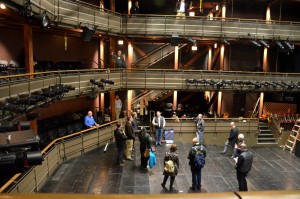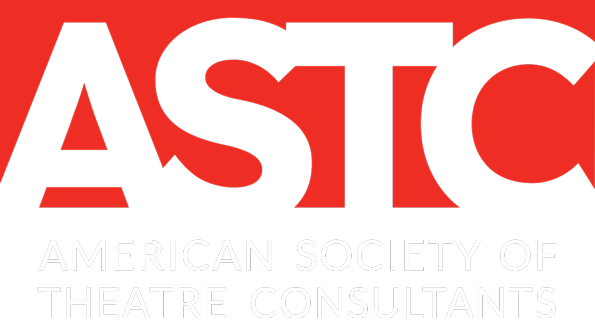Client Involvement in the Theatre Design Process
By Michael Parrella, ASTC

ASTC Members and others touring the Owen Theatre at the Goodman, Chicago as part of the USITT / OISTAT Architecture Commission Meeting in 2018. ASTC members use tours to learn about user’s experiences in their buildings. Photo by Paul Sanow, ASTC.
A theatre consultant’s most successful and enjoyable projects involve an architect eager to work collaboratively to incorporate the theatre-specific design requirements within their larger aesthetic vision for the venue.
Most important, however, is an engaged client who has articulated a clear vision for the venue and its use upon opening and into the future. The client’s vision and participation in the entire process are of singular importance to the success of any project. The client’s vision serves as the design team’s North Star throughout the design and construction processes as decisions are made to determine the form of the venue, what specific needs and constituent groups the venue must serve, and what features and equipment it will have. All decisions must align with the client vision.
Client groups can take various forms: end users including relevant artistic visionaries, leadership of the given arts organization, as well as production managers, technical directors and other staff. Each stakeholder has their own unique needs which must be addressed. Some larger institutional clients, such as universities, museums, and commercial developments, may have additional stakeholders including boards of directors, fundraising personnel, campus planners and architects, developers, project managers, and entire staffs who are charged with building and subsequently maintaining facilities. While these additional participants provide their own valuable input, frequently they do not understand what is required to stage events within a new venue.
Design teams also have many participants including the architect, engineers, theatre consultant, acoustician, cost consultant, and other specialty design professionals. While the architect supplies the broad, overarching plan to realize the client’s vision, the theatre consultant is a specialist who provides functional requirements that allow a venue to fulfill the client vision and serve its many users including artists, technicians, administrators, and audience, as well as financial obligations. As a collaborative member of this design team, one of the theatre consultant’s roles is to advocate for the interests of the end users as their needs align with the client vision. Frequently, theatre consultants are hired directly by architects with whom we have built relationships through past collaborations, but sometimes theatre consultants can be hired directly by clients and end users. Either approach can work so long as the client is aware of the contractual structure and has access to clear dialog with the entire design team when necessary.
As client groups become more complex and multiple levels of contractual relationships are put in place between the client and various members of the design team, the actual end users of the facility – the ones who understand how the completed venue will need to operate – can easily become separated from the critical decision making that takes place during a design process. However, when clients and end users are engaged partners in a balanced design process, more informed collaboration is possible which inherently produces a venue that better serves the client vision. Where possible, production managers, technical directors and other end users should be empowered to participate in the design process. They have deep institutional knowledge and they will be operating the venues long after construction is completed. If a new venue is being built from scratch, frequently there are no end users to bring into the process during the design phases. In these situations, the theatre consultant will work to plan a venue that can function based on the expressed client vision and an intimate knowledge of the entertainment industry and its expectations for a new venue.
Regardless of the structure of the client group, the vision it puts forward may need to adjust as the design process advances and the reality of project constraints arise. These include site limitations, budget limitations, and schedule realities. Theatre consultants can make recommendations to the design team and client group to prioritize essential infrastructure, or other key aspects of the client’s vision that would be difficult to address after the initial building project is completed. It is imperative to note however, that the participation of the client in a cost reduction process is essential to the ultimate success of the project. When the client’s expectations must be modified to fit project constraints, the client must be involved.
Some institutional clients worry that if the architect and theatre consultant have too much interaction with the end users of the new venue, the design team will attempt to accommodate all of the end users’ whims and wishes, causing the project to exceed its budget. A theatre consultant understands the aspirations and requirements of the various user groups and helps the client and the entire design team prioritize those goals into a set of clear directions. This process keeps the project moving towards the broader client vision, even as a scope may need to be modified to fit a budget.
Every constituent user group might not receive all that it asked for in a completed venue, but with the help of the theatre consultant, and clear paths of communication, constituent needs can be properly addressed. A client that is informed, involved, and participating in this decision-making process is a client that will be happier with their completed venue.
Disclaimer: Any views or opinions expressed in this article are solely those of the author and do not necessarily represent those of the American Society of Theatre Consultants. This article is for general information only and should not be substituted for specific advice from a Theatre Consultant, Code Consultant, or Design Professional, and may not be suitable for all situations nor in all locations.


